|
The Queen Elisabeth Competition, a Hard Gateway to Success (No.19)
3rd of June 2013
The day before yesterday, at the final of the Queen Elisabeth International Music Competition (Piano), the first prize was won by the Israeli Boris Giltburg. 12 pianists competed in the final after having passed the two qualifying rounds. Unfortunately there was not a single Japanese candidate. The performance of the 8 Japanese candidates in the first round was not good and only one Japanese female candidate went on to the second round (semi-final), but she did not make it to the final either. I have listened to the performance of almost all candidates from the first round on, either at the concert venue or via the live broadcast on TV and I was not only surprised by the high level of the performance. I was also amazed by the length of the competition (one month) and by the number of works that the candidates need to play in every round. In the first round the candidates have to play in total 4 to 5 works, compulsory works and a work of one’s choice included. In the semi-final the candidates perform on different days a concerto accompanied by a live orchestra and a solo recital of 40 - 50 minutes (3 to 4 works). In the final the candidates perform two concertos including a compulsory work and one sonata. Therefore, the candidates need memorize more than 10 musical scores for their performance. In this case, the burden for students at music schools is heavy. Therefore, it is inevitable that most candidates have played already many recitals and have reached a semi-professional level. Different from the former competitions, this time most of the East Asian candidates such as the Chinese and South Koreans lost already by the semi-final and were unable to reach top positions. Also, regardless of the nationality, the results for the female candidates were harsh. After all, I sensed that the Queen Elisabeth Competition is a very tough competition and it is very difficult to sneak through this hard gateway to success.
< Three Local Politicians >
About ten days ago, I visited Mr. Jan PEUMANS, President of the Flemish Parliament and we talked about the structure and activities of the regional parliament. The capital of the Flemish region is Brussels, so the Flemish Parliament as well is located in the center of Brussels. It is a modern building totally fitted with glass and also the facilities are up-to-date. There are 124 members of Parliament in total. The leading party is the Christian Democratic Party, but the President belongs to the New Flemish Alliance (NVA), the fifth largest party. It is a bit strange. The seating arrangement in the cafeteria for the deputies was very interesting: the tables are arranged in such a way that 7-8 people can have a conversation, but each table of the more or less 10 tables is allocated to each party in advance, so the deputies cannot sit freely where they want. Currently the Protocol Amending the Income Tax Convention between Japan and Belgium is being deliberated, but I was relieved to hear that the Protocol would be approved in the plenary session in a few days.
At the end of last month, I visited Mons city and met with Mr. Tommy Leclercq, Governor of Hainaut and Mr. Nicolas Martin, Mayor of the city. Both are young politicians and were appointed not long ago, but it seemed to me that they tackle their work enthusiastically. Their careers are very similar: both have experience as director of the Minister's-president Secretariat of the Walloon Region and both worked with the then Minister-President Mr. Elio Di Rupo. I had a preconception that Hainaut was the poorest region in Belgium because of the decline in the coal and steel industry which was once flourishing, but in recent years the region made a significant economic comeback thanks to an active foreign investment policy and to the promotion of cutting-edge industries linked to the University of Mons. In the IT industry in particular, the activities of the Data Management Department of the American Google and Microsoft attract extensive interest. In addition, Mons has been designated the European Capital of Culture in 2015, so the whole city is showing signs of a construction boom, for example the total renovation of the Central Station. Since several Japanese companies such as AW Europe are operating in Hainaut as already mentioned in Ambassador‘s Chat No.7, I asked the governor and the mayor for their continued support.
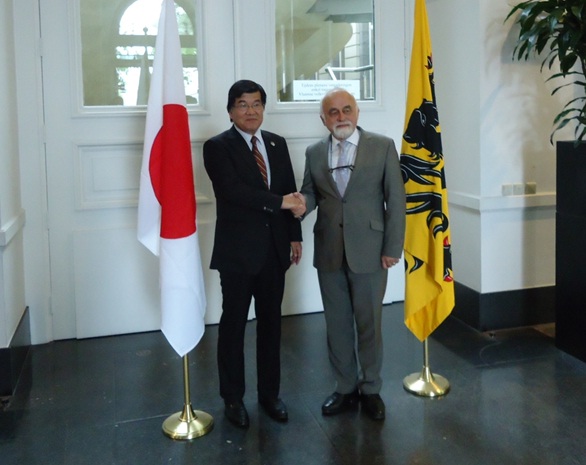 |
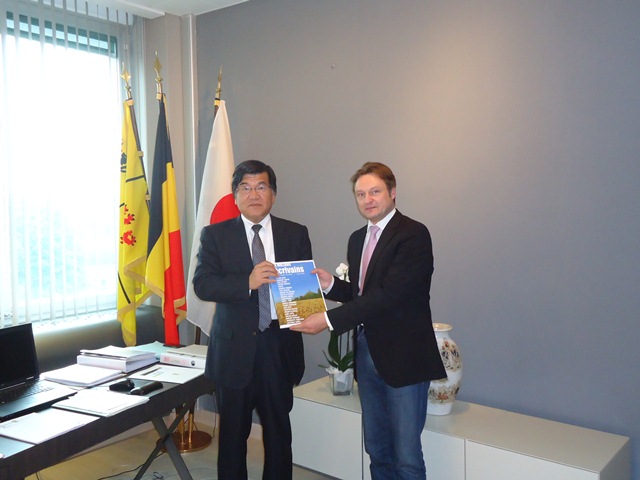 |
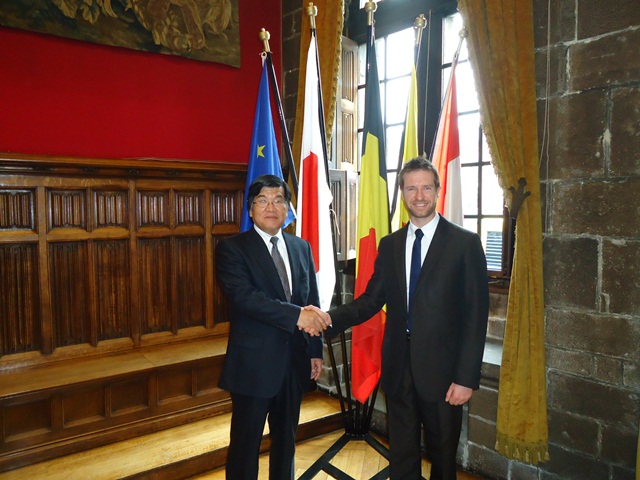 |
| President of the Flemish Parliament |
Governor of Hainaut |
Mayor of Mons |
< Unique Event by iTQi >
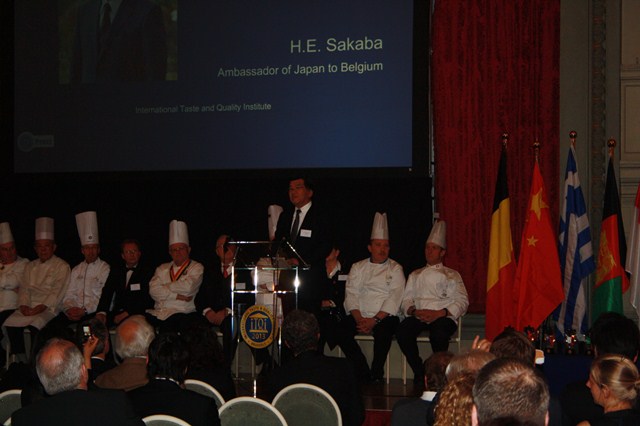 End of last month, an international food fair event was held by iTQi in Brussels and I attended the award ceremony as one of the guests on the final day. iTQi is an abbreviation for International Taste & Quality Institute which is a Belgian private institute and since 9 years now they have been organizing this food fair. This year 1239 products from 54 countries were subject to evaluation, among which 213 products from 173 Japanese companies. As a result of the rigorous examination by more than 100 European celebrity chefs and sommeliers, 253 products, including 55 Japanese products, won the Superior Award (three golden stars). When a product receives three stars three years in a row, a Crystal Award is granted. 9 Japanese products were granted the honor this year. If we look at the award winners, Japanese sake is generally highly evaluated, but also Japanese sweets, noodles and dairy products have received the Crystal Award. Surprisingly, drinks such as the mineral water called “Reihou-no-mizu” and fresh tea as well were highly assessed. Japan being the “country of honor” at this year’s fair, I was given the opportunity to make a speech. I mentioned that Japanese food represents the Japanese culture and that the Abe administration even adopts the “Cool Japan” theme in its growth strategy in which they try to place “food” in the center. Japanese cuisine and Japanese food are one and I am glad that the international rating is growing. The results of this year’s evaluation by iTQi are very encouraging for the Japanese government, which is promoting “the Japanese Food Culture” internationally. End of last month, an international food fair event was held by iTQi in Brussels and I attended the award ceremony as one of the guests on the final day. iTQi is an abbreviation for International Taste & Quality Institute which is a Belgian private institute and since 9 years now they have been organizing this food fair. This year 1239 products from 54 countries were subject to evaluation, among which 213 products from 173 Japanese companies. As a result of the rigorous examination by more than 100 European celebrity chefs and sommeliers, 253 products, including 55 Japanese products, won the Superior Award (three golden stars). When a product receives three stars three years in a row, a Crystal Award is granted. 9 Japanese products were granted the honor this year. If we look at the award winners, Japanese sake is generally highly evaluated, but also Japanese sweets, noodles and dairy products have received the Crystal Award. Surprisingly, drinks such as the mineral water called “Reihou-no-mizu” and fresh tea as well were highly assessed. Japan being the “country of honor” at this year’s fair, I was given the opportunity to make a speech. I mentioned that Japanese food represents the Japanese culture and that the Abe administration even adopts the “Cool Japan” theme in its growth strategy in which they try to place “food” in the center. Japanese cuisine and Japanese food are one and I am glad that the international rating is growing. The results of this year’s evaluation by iTQi are very encouraging for the Japanese government, which is promoting “the Japanese Food Culture” internationally.
< The Ballet School of Antwerp >
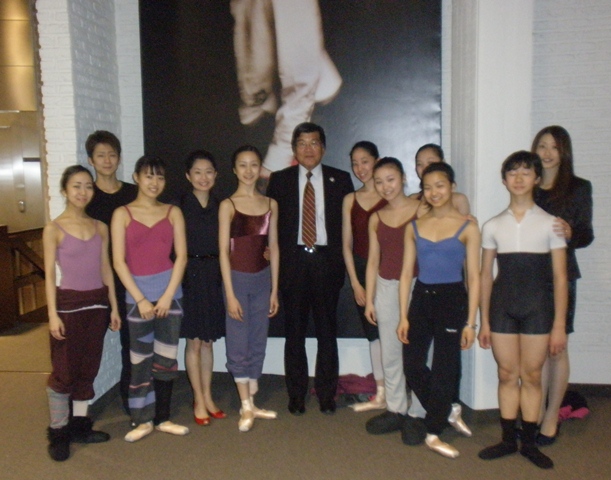 About 10 days ago, I visited the Royal Ballet School of Antwerp and had a talk with Director Annick Liesenborghs about the school activities and the relationship with Japan. I knew that the Japanese ballerina Ms. Aki Saito was a prima ballerina at the Royal Ballet in Antwerp, but I did not know the school at all, so what I saw and heard was full of surprise. The Royal Ballet School opened its doors in 1951. At present, there are 87 students among which 13 Japanese students from 14 to 20 years old and there is even a Japanese teacher. Japanese students form the largest group of foreign students. The school goes every year to Japan to recruit students and 7 new Japanese students will enter the school this September. The youngest student, Mr. Mikiya Hashigo, is still a junior high school student. Studying ballet while attending a local school in Dutch language must be hard, I think. So it is really my hope that he will play a part in the Japanese ballet world in the future. About 10 days ago, I visited the Royal Ballet School of Antwerp and had a talk with Director Annick Liesenborghs about the school activities and the relationship with Japan. I knew that the Japanese ballerina Ms. Aki Saito was a prima ballerina at the Royal Ballet in Antwerp, but I did not know the school at all, so what I saw and heard was full of surprise. The Royal Ballet School opened its doors in 1951. At present, there are 87 students among which 13 Japanese students from 14 to 20 years old and there is even a Japanese teacher. Japanese students form the largest group of foreign students. The school goes every year to Japan to recruit students and 7 new Japanese students will enter the school this September. The youngest student, Mr. Mikiya Hashigo, is still a junior high school student. Studying ballet while attending a local school in Dutch language must be hard, I think. So it is really my hope that he will play a part in the Japanese ballet world in the future.
< Exhibition in the Gaasbeek Castle >
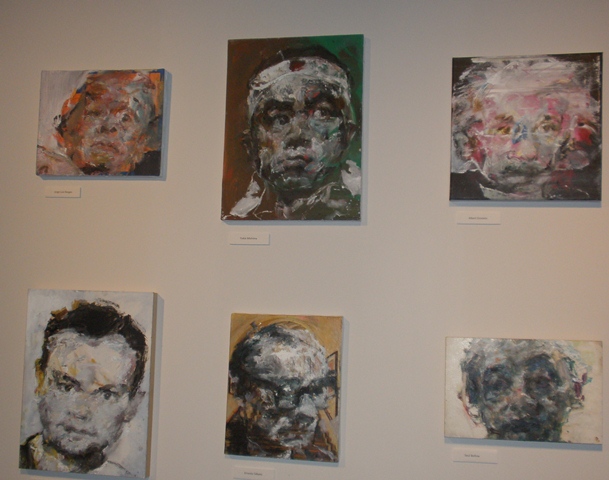 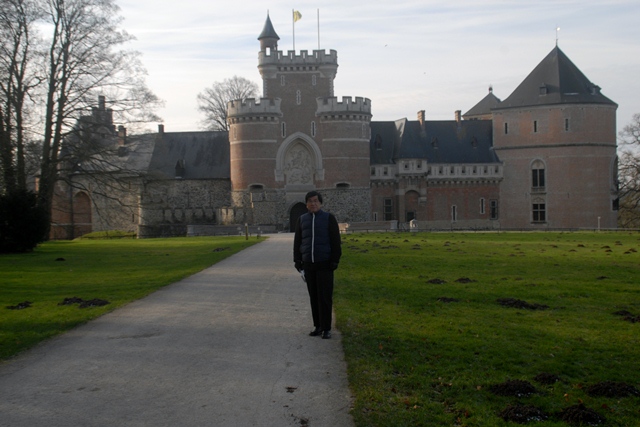 The famous Gaasbeek Castle is situated 12km to the southwest of Brussels. At first glance, you could mistake it for a medieval castle, but in fact the current building was completely restored at the end of the 19th century and since 32 years it is the property of the Flemish government. The other day, I was invited to the opening of the solo exhibition of the Belgian portrait painter Sam Dillemans in this castle. Among the hundreds of portraits, there were also portraits of Yukio Mishima and Kenzaburo Oe, suggesting the worldwide interest of the painter. What caught my interest even more than the artist himself was the splendour of the tapestries adorning the walls of Gaasbeek Castle. The tapestries are works from the 15th to 17th century, and one can definitely feel the high level of the fabric technology in those days. This castle is also famous as the place where the Count of Egmond, who revolted against the rule of Spain and planned the struggle for independence, spent 3 years before being arrested and executed in the second half of the 16th century. If we go back even further in time, it is also the place where the master of Flemish painting, Pieter Breughel, stopped by to paint his landscapes and the castle is noted in connection with Rubens as well (his handwritten last will and testament is kept here). The garden in the castle’s courtyard has been laid out in the style of a French garden and when I visited, several peacocks were leisurely strolling around. Historical monuments including these castles and churches can be found everywhere in Belgium, which makes the history of this country very tangible. The famous Gaasbeek Castle is situated 12km to the southwest of Brussels. At first glance, you could mistake it for a medieval castle, but in fact the current building was completely restored at the end of the 19th century and since 32 years it is the property of the Flemish government. The other day, I was invited to the opening of the solo exhibition of the Belgian portrait painter Sam Dillemans in this castle. Among the hundreds of portraits, there were also portraits of Yukio Mishima and Kenzaburo Oe, suggesting the worldwide interest of the painter. What caught my interest even more than the artist himself was the splendour of the tapestries adorning the walls of Gaasbeek Castle. The tapestries are works from the 15th to 17th century, and one can definitely feel the high level of the fabric technology in those days. This castle is also famous as the place where the Count of Egmond, who revolted against the rule of Spain and planned the struggle for independence, spent 3 years before being arrested and executed in the second half of the 16th century. If we go back even further in time, it is also the place where the master of Flemish painting, Pieter Breughel, stopped by to paint his landscapes and the castle is noted in connection with Rubens as well (his handwritten last will and testament is kept here). The garden in the castle’s courtyard has been laid out in the style of a French garden and when I visited, several peacocks were leisurely strolling around. Historical monuments including these castles and churches can be found everywhere in Belgium, which makes the history of this country very tangible.
< Prime Minister Di Rupo and the Festival in Mons >
 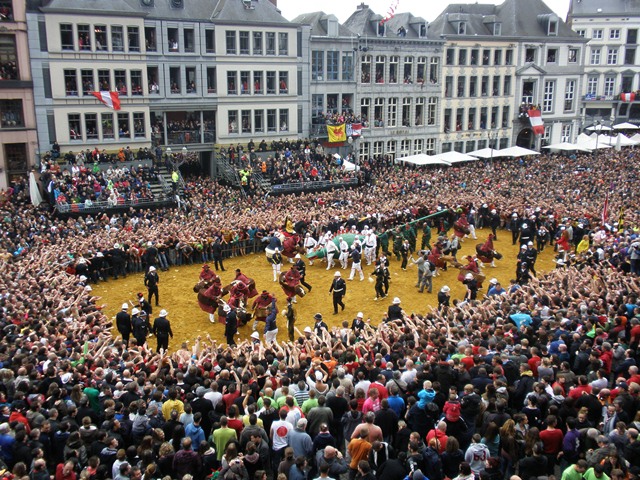 The weekend before last, I visited the “Patron Saint Festival” of Mons. At this festival, held every year on the first Sunday after Pentecost, a procession with the “Golden Coach” carrying the relics of Saint Waudru around takes place in the morning (See Ambassador’s Chat No. 15) and in the afternoon, the battle between Saint George and the dragon, called the “Lumeçon” is re-enacted at the main square. As I was invited by the previously mentioned mayor, Mr Martin, I watched the spectacle from the city hall’s balcony. The battle at the “Doudou Festival” lasts about 40 minutes during which the excitement of the more than 30.000 citizens gathered at the main square, reaches its peak. In light rain and in unseasonably cold weather unfortunately, young half-naked men cause an uproar pushing and shoving with such pressure that as a spectator you wonder whether no one gets hurt. Dating back to the 14th century, the “Doudou” unfolds in a setting that was built from the Middle Ages to the modern times, so I had somewhat the illusion of being caught in a time-slip. However, the fact that Saint George who was dressed up as a knight used a handgun to slay the dragon might be the modern style. Furthermore, at the reception for the guests held at the occasion of this festival, I met the Prime Minister, Mr Di Rupo. The Prime Minister is originally from Mons and 13 years ago he became mayor of the city. Even now, he still has that title pro forma. During our short conversation, the Prime Minister showed a strong interest in the economic policy of the Abe administration. Also in Europe, many are passionately gazing at “Abenomics” right now. The weekend before last, I visited the “Patron Saint Festival” of Mons. At this festival, held every year on the first Sunday after Pentecost, a procession with the “Golden Coach” carrying the relics of Saint Waudru around takes place in the morning (See Ambassador’s Chat No. 15) and in the afternoon, the battle between Saint George and the dragon, called the “Lumeçon” is re-enacted at the main square. As I was invited by the previously mentioned mayor, Mr Martin, I watched the spectacle from the city hall’s balcony. The battle at the “Doudou Festival” lasts about 40 minutes during which the excitement of the more than 30.000 citizens gathered at the main square, reaches its peak. In light rain and in unseasonably cold weather unfortunately, young half-naked men cause an uproar pushing and shoving with such pressure that as a spectator you wonder whether no one gets hurt. Dating back to the 14th century, the “Doudou” unfolds in a setting that was built from the Middle Ages to the modern times, so I had somewhat the illusion of being caught in a time-slip. However, the fact that Saint George who was dressed up as a knight used a handgun to slay the dragon might be the modern style. Furthermore, at the reception for the guests held at the occasion of this festival, I met the Prime Minister, Mr Di Rupo. The Prime Minister is originally from Mons and 13 years ago he became mayor of the city. Even now, he still has that title pro forma. During our short conversation, the Prime Minister showed a strong interest in the economic policy of the Abe administration. Also in Europe, many are passionately gazing at “Abenomics” right now.
|

